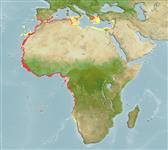>
Carangiformes (Jacks) >
Carangidae (Jacks and pompanos) > Caranginae
Etymology: Caranx: French, carangue, the name of a Caribbean fish; 1836 (Ref. 45335).
Environment: milieu / climate zone / depth range / distribution range
Ecología
marino; salobre bentopelágico; rango de profundidad 30 - 200 m (Ref. 27584), usually 30 - 50 m (Ref. 26999). Subtropical; 15°C - 22°C (Ref. 57055); 39°N - 22°S, 19°W - 36°E
Eastern Atlantic: Morocco to Angola (Ref. 4225, 57392), including the Mediterranean along the African coast. Range reported to extend south to Namibia (Ref. 27121).
Length at first maturity / Tamaño / Peso / Age
Maturity: Lm ?, range 20 - ? cm
Max length : 60.0 cm TL macho / no sexado; (Ref. 57392); common length : 35.0 cm TL macho / no sexado; (Ref. 3397); peso máximo publicado: 1.0 kg (Ref. 27584)
Short description
Claves de identificación | Morfología | Morfometría
Espinas dorsales (total) : 9; Radios blandos dorsales (total) : 28 - 32; Espinas anales: 3; Radios blandos anales: 25 - 28. Diagnosis: body elongate and slightly compressed, its depth comprised from 3.8 to 4.4 times in fork length; eye posteriorly with a well developed adipose eyelid; 2 well separated dorsal fins, 1st with 8 spines, 2nd with 1 spine and 28-32 soft rays; anal fin with 2 detached spines, followed by 1 spine and 25-28 soft rays; last dorsal and anal ray transformed into a partially separate finlet, connected to the preceding ray by a low interradial membrane; pectoral fins short (comprised from 1.0 to 1.2 times in head length); scales small and cycloid; curved part of lateral line with 45-55 scales and 0-3 scutes, straight part with 0-8 scales and 24-32 scutes (Ref. 57392).
Coloration: back brownish to olivaceous, sides light olivaceous to whitish; a narrow yellowish band sometimes extending from head to caudal-fin base; a black spot on upper margin of gill cover; a black blotch with a narrow light distal margin present on second dorsal-fin lobe (Ref. 57392).
Form schools. They occur frequently near the bottom, mostly in depths of 30 to 50 m. Also pelagic and found near the surface at times. Entering brackish-water lagoons and estuaries (Ref. 57392). Feed on small fish and invertebrates (Ref. 3195). Spawning grounds are located in shallow waters (Ref. 57055). Eggs are pelagic (Ref. 4233).
A partial spawner (Ref. 57055).
Smith-Vaniz, W.F., J.-C. Quéro and M. Desoutter, 1990. Carangidae. p. 729-755. In J.C. Quero, J.C. Hureau, C. Karrer, A. Post and L. Saldanha (eds.) Check-list of the fishes of the eastern tropical Atlantic (CLOFETA). JNICT, Lisbon; SEI, Paris; and UNESCO, Paris. Vol. 2. (Ref. 7097)
IUCN Red List Status (Ref. 130435: Version 2024-1)
Threat to humans
Harmless
Human uses
Pesquerías: comercial
Herramientas
Can't connect to MySQL database fbquizv2. Errorcode: Too many connections
